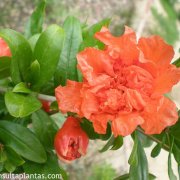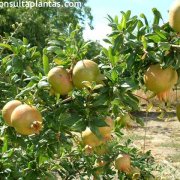Care of the shrub Punica granatum or Pomegranate |
|
The genus Punica, Lythraceae family, includes 2 species of shrubs native to Central Asia and Africa (Somalia). The species are: Punica granatum and Punica protopunica. Common name: Pomegranate. This species is native to Central Asia. They are slow-growing deciduous shrubs with long, thorny branches that reach 5 meters (16.4 feet) in height. The leaves are opposite, bright green and oblong-lanceolate in shape. They produce attractive large red flowers and edible fruits known as pomegranates. They bloom in late spring and early summer. Pomegranate is used as fruit trees, as isolated specimens and in small bushy groups. It can also be grown in pots for patios and terraces, especially the "Nana" variety. Punica granatum needs full sun exposure and a warm-temperate climate. It resists light and occasional frosts. The soil must be very well drained and contain abundant organic matter. Water regularly in spring and summer at the rate of once a week; the rest of the year water moderately. Punica granatum resists drought well. At the end of winter, prune intensively to maintain a compact appearance and allow all the branches to receive light. Fertilize every 20 days in spring and summer with mineral fertilizer. Pomegranate is a plant resistant to the usual pests and diseases. Punica granatum is propagated from seeds and by layering in spring and by dividing the suckers that sprout at the base of the plant. |
Images of the shrub Punica granatum or Pomegranate |
Find plants
Punica granatum or Pomegranate | Care and Growing
© 2025 FavThemes







